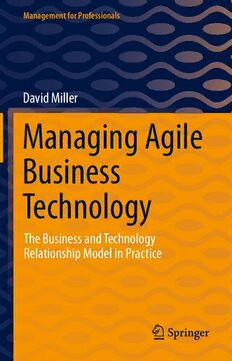
Managing Agile Business Technology: The Business and Technology Relationship Model in Practice PDF
Preview Managing Agile Business Technology: The Business and Technology Relationship Model in Practice
Management for Professionals David Miller Managing Agile Business Technology The Business and Technology Relationship Model in Practice Management for Professionals The Springer series Management for Professionals comprises high-level business and management books for executives. The authors are experienced business professionals and renowned professors who combine scientific background, best practice,andentrepreneurialvisiontoprovidepowerfulinsightsintohowtoachieve businessexcellence. Moreinformationaboutthisseriesathttps://link.springer.com/bookseries/10101 David Miller Managing Agile Business Technology The Business and Technology Relationship Model in Practice DavidMiller Derby,UK ISSN2192-8096 ISSN2192-810X (electronic) ManagementforProfessionals ISBN978-3-030-90597-2 ISBN978-3-030-90598-9 (eBook) https://doi.org/10.1007/978-3-030-90598-9 #TheEditor(s)(ifapplicable)andTheAuthor(s),underexclusivelicensetoSpringerNatureSwitzerland AG2022 Thisworkissubjecttocopyright.AllrightsaresolelyandexclusivelylicensedbythePublisher,whether thewholeorpartofthematerialisconcerned,specificallytherightsoftranslation,reprinting,reuseof illustrations, recitation, broadcasting, reproduction on microfilms or in any other physical way, and transmission or information storage and retrieval, electronic adaptation, computer software, or by similarordissimilarmethodologynowknownorhereafterdeveloped. Theuseofgeneraldescriptivenames,registerednames,trademarks,servicemarks,etc.inthispublication doesnotimply,evenintheabsenceofaspecificstatement,thatsuchnamesareexemptfromtherelevant protectivelawsandregulationsandthereforefreeforgeneraluse. The publisher, the authors, and the editorsare safeto assume that the adviceand informationin this bookarebelievedtobetrueandaccurateatthedateofpublication.Neitherthepublishernortheauthorsor theeditorsgiveawarranty,expressedorimplied,withrespecttothematerialcontainedhereinorforany errorsoromissionsthatmayhavebeenmade.Thepublisherremainsneutralwithregardtojurisdictional claimsinpublishedmapsandinstitutionalaffiliations. ThisSpringerimprintispublishedbytheregisteredcompanySpringerNatureSwitzerlandAG. Theregisteredcompanyaddressis:Gewerbestrasse11,6330Cham,Switzerland ’ Author s Note Making business technology work in what can be a complex, ambiguous, and dynamicworldisnoteasyandourfailuresmightleadpeopletothinkthatourability tomanagethetechnologyhasn’tkeptpacewiththetechnologyitself.Thetechnol- ogy now has many agile characteristics but our management processes are some- timesseenasanobstacletobeovercome.Wemustchangethewayweworkandthe booksetsoutwhythat’sthecase,howthiscanbeachieved,andthemanybenefits. The reader is given a conceptual solution and implementation choices. It has been written for business managers, business technology managers, and technology serviceproviders(TSPs)butinalanguagethathopefullyeverybodywillunderstand. Thisisimportantbecauseinanagewheneveryoneisaffectedbybusinesstechnol- ogy, at all levels right across the extended enterprise, we ideally need all stakeholders to contribute and collaborate in its management and governance. It’s alsoimportantbecause,giventheopportunity,goodideascancomefromthemost unlikelyplaces.DM v Preface ITserviceprovidershaveneverhadacompletepictureofhowwelltheyaredoing, andsomemightaddthattheyhaveneverhadanup-to-dateandcompletepictureof whattheyweresupposedtodo.Weneedtochangethewaywework. In the frequent absence of a detailed and complete specification of what was required,packagedsolutions,methodologiesandmaturitymodelsbecametheorder of the day. In organisations where little changed, this almost worked but success rates remained stubbornly low, even where specifications existed. As globalisation took hold, as the business landscape became more complex, as businesses had to become more dynamic and distributed, as it became impossible to know who to gather together to thrash out a problem, and as business demanded the earlier delivery of working solutions, our working methods have somehow failed to keep up.Weneedtochangethewaywework. The modern world is complex, ambiguous, and dynamic. It is characterised by turbulentmarkets,shorterproductlifecycles,disruptivetechnologies,industrystruc- ture change, high staff turnover, changes in employment status, increased home working, and changes to other working practices and daily life brought about by pandemics—or the possibility thereof, the digital economy, and the emergence of typesofartificialandnon-consciousintelligence,etc.Mostbusinessesnowinvolve technologyofmanykinds,mayhavemultipletechnologyserviceproviders(TSPs), and customers and suppliers will have their own technology arrangements. As a consequence,ourworldisalwayspresentingmultiplechallengesandopportunities that require a technology solution of one kind or another, and it’s not unusual for something new to impact work that is in progress more than once prior to its implementation. Itcanbearguedthatthebusinessworldhasalwaysbeeninastateoffluxanditis surprising then that from the business perspective, there has never been a coherent business technology management and governance model that takes account of the truenatureofourworld.Instead,wemostlyhavejustabricolageofITmethodsand standardsforITdeliverythatareasopaque tobusinesspeopleasissometimesthe technology itself. Perhaps for this reason, the last 50 or more years of IT manage- ment has been characterised by uncertain processes yielding unpredictable outcomes. To adopt a motoring analogy, IT management methods applied over this time have been like driving by occasionally controlling what is happening under the bonnet but without really looking where we are going except at the start vii viii Preface and occasionally at the end of our journey. Whilst the advent of Agile IT methods mayhavehelpedustopushdownontheacceleratorpedal,theyhaveofferedlittlein the way of navigation, steering or hindsight. As technology of many kinds determines, and gets embedded within, our business processes, we need to change thewaywework. Thisbookofferssomeinsightintohowwecoulddothat. Derby,UK DavidMiller Introduction The widespread dissatisfaction with existing IT management methods and the recognition that something else was needed for the emerging and future worlds werethetwodriversbehindmywork. What has emerged from that work is exciting and universally appealing. The book describes a breakthrough model which suggests a new management and governancephilosophyanddiscussesthepotentialadvantagesofferedbyaconcep- tualmanagementsystembasedonthese. The new model, the Business and Technology Relationship Model (BTRM), is researchbased,peerreviewedandfullydescribestherelationshipbetweenbusiness and technology. Its discovery has been described by one industry analyst as ‘mind shifting’and‘beautiful’providingsimpledefinitionsforservicequality,alignment, agility, and governance that have hitherto escaped adequate definition. It explains our problems with traditional methods, democratises the management and gover- nanceofbusinesstechnologytomaximisecollaborationatalllevels,andlendsitself tointroducingautomation. Active Management and Governance is a conceptual Big Data management system, developedfrom theBTRM, that illustrates thepotentialfor real-time,real- worldinsightandcontrolthatpreviouslycouldn’tbecontemplated.This,combined withitsfocusonvaluecreationaswellasvaluedelivery,willfacilitateautomation and continuous transformational change and will do so in the context of current, emerging, and future technologies. How it can do this is described in full with enough information to plan an implementation, understand where AI can be lever- aged, and how it can hasten a ‘Very Agile’ world and provide a control for self- managingsystems. Thebenefitswillbefeltinallorganisations.Nojudgementorpredictionhasbeen made interms whether traditional IT management methods will prevailwithin this newmanagementframeworkortowhatextentbuttheywillcertainlychange.Infact, ActiveManagementandGovernancemayevenchangethewayinwhichwemanage thebusinessitself. Whyabookratherthanaproduct?Becauseoftheuniversalappealoftheconcept there may be stages of adoption ranging from a management philosophy that just changesthewaywethinkaboutmanagingbusinesstechnology,oracustomisation of an existing platform of some kind, to a specialist and sophisticated software product. There may be many variations on these themes depending on the ix x Introduction developer’s industry focus and specialist insights, and some may already be appearing in the market place. Hence it is hoped that a book which describes the philosophyandimportantconceptsinsomedetailratherthananinterpretationbased on a restricted view will have more appeal and encourage greater innovation and wideradoption. Chapter 1 looks back at the way technology has been managed historically, the difficulties that this has created and why it was necessary to re-think the problem. Chapter 2 describes the BTRM and how it changes the management storyline. Chapter 3 introduces Active Management and Governance to describe how the BTRM might be implemented in practice. Our thinking is often constrained by what has gone before and so Chap. 4 explains how the business landscape can be analysed in ways that have not previously been possible. Chapter 5 addresses the growing importance of AI and considers various pathways of opportunity for a businesswishingtoexploitlearningalgorithmsandothernon-consciousintelligence toenhance ActiveManagementandGovernance.Chapter6considersthemanage- mentphilosophyofActiveManagementandGovernanceanditspotential,notjust formanagingbusiness technology,butasauniversal business managementframe- workwhichisconsistentwithcorporategovernancepractices.
